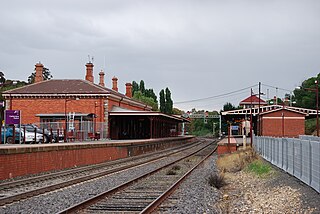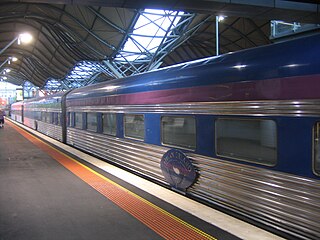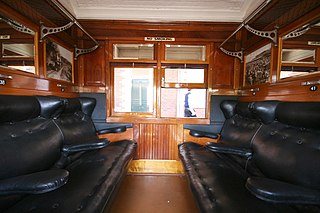Related Research Articles

Castlemaine railway station is a regional railway station on the Deniliquin line, which is part of the Regional railway network. It serves the north-western suburb and town of Castlemaine, in Victoria, Australia. Castlemaine station is a ground level unstaffed station, featuring two side platforms. It opened on 21 October 1862.

The Victorian Goldfields Railway is a 1,600 mm broad gauge tourist railway in Victoria, Australia. It operates along a formerly disused branch line between the towns of Maldon and Castlemaine.

The Tait trains were a wooden bodied electric multiple unit (EMU) train that operated on the suburban railway network of Melbourne, Victoria, Australia. They were introduced in 1910 by the Victorian Railways as steam locomotive hauled cars, and converted to electric traction from 1919 when the Melbourne electrification project was underway. The trains derived their name from Sir Thomas James Tait, the chairman of commissioners of the Victorian Railways from 1903 to 1910. The first cars were built during 1909 with the last entering service in 1952.

The N Class are a class of diesel locomotives built by Clyde Engineering in Somerton for V/Line between 1985 and 1987.

The B class are a class of diesel locomotives built by Clyde Engineering, Granville for the Victorian Railways in 1952–1953. Ordered and operated by the Victorian Railways, they initiated the dieselisation of the system and saw use on both passenger and freight services, with many remaining in service today, both in preserved and revenue service. Some were rebuilt as the V/Line A class, while others have been scrapped.

The Diesel Electric Rail Motor (DERM) was a type of railmotor operated by the Victorian Railways in Australia.

The DRC was a class of railmotor operated by the Victorian Railways on its country rail network in Victoria, Australia. The cars were built by Tulloch Limited in New South Wales, and featured aluminium and steel construction, air-conditioning, and twin diesel engines with hydraulic transmissions.

The N type carriages are an intercity passenger carriage used on the railways of Victoria, Australia. They were introduced between 1981 and 1984 as part of the 'New Deal' reforms of country passenger rail services. Today they are seen on both V/Line long distance InterCity services, and limited commuter services to Geelong.

The S type carriages are a corridor-type passenger carriage used on the railways of Victoria, Australia. The first carriages were constructed by the Victorian Railways in 1937 for use on the Spirit of Progress, with additional carriages built for other trains until the mid-1950s.

The Z type carriages are an air conditioned steel passenger carriage used on the railways of Victoria, Australia. The carriages were constructed by the Victorian Railways from 1957 for use on interstate services.

The W type carriages were wooden passenger carriages used on the railways of Victoria, Australia. There were two variants, short- and long-body vehicles, and this article deals with the former. Details on the latter can be found here.

The Victorian Railways' (VR) Royal Trains operated to transport members of the royal family on their numerous tours of Australia on the Victorian rail network. The same carriages were also used for a number of vice-regal trains for the governor-general of Australia and the governor of Victoria. The last Royal Train ran in 1988.
As the Victorian Railways' fleet of Z vans began to age, the railways decided to invest in bogie designs for vans. Some van designs were included in a class of new passenger vehicles. Many other vans, for both freight and passenger work, were built separately from any other rolling stock developments, and these are the ones that feature here in detail.
The V type carriages, introduced from 1897, were the first group of Victorian Railways passenger rolling stock to have their own distinct class.
This article is intended as a catalogue of sleeping carriages used by the Victorian Railways and successors.

Between 1936 and 1942, South Australian Railways built 36 steel carriages at its Islington Railway Workshops. All were painted cream and green being repainted maroon and silver in the 1960s. Aside from a few written off after accidents, all passed to Australian National in March 1978.

The first passenger cars built specifically for The Overland train service operated by the Victorian and South Australian Railways (V & SAR) were introduced in 1949. By the end of 1951, eight new sleeping cars and six new sitting cars had entered service. Additions to the fleet continued until 1972; in all, 44 carriages were built. About eight were still in service as of 2024 on The Overland operated by Journey Beyond. Other carriages have been transferred to different services or sold.

The E type carriages were wooden express passenger carriage used on the railways of Victoria, Australia. Originally introduced by Victorian Railways Chairman of Commissioners Thomas James Tait for the interstate service between Melbourne, Sydney and Adelaide, these Canadian-inspired carriages remained in regular service for 85 years over the entire Victorian network.

The W type carriages were wooden passenger carriages used on the railways of Victoria, Australia.
References
- ↑ "VR History".
- ↑ "Train of Knowledge?".
- ↑ Newsrail January 1984 p.60
- ↑ "Steamrail Northern Weekender". 12 June 2011.
- ↑ Newsrail May 1997
- ↑ Newsrail March 1984 p.88
- ↑ Newsrail March 1984 p.88
- ↑ Newsrail March 1984 p.88
- ↑ Newsrail March 1984 p.88
- ↑ Newsrail March 1984 p.88
- ↑ "pjv101.net/cd/pages". pjv101.net.
- ↑ Newsrail December 1984 p.377
- ↑ Newsrail March 1984 p.88
- ↑ Newsrail January 1984 p.60
- ↑ Newsrail August 1984 p.248
- ↑ "TOK". 27 November 1986.
- ↑ "STUDENTS IN THE TRAIN OF KNOWLEDGE MAKING BEDS - Public Record Office Victoria".